The strongest known fast radio burst has been traced to a 7-galaxy pileup
The galactic smashup is located 11 billion light-years from Earth

Seven galaxies are converging in a space the size of the Milky Way, triggering star formation and, perhaps, odd explosions like fast radio bursts.
NASA, ESA, STScI, Alexa Gordon/Northwestern







